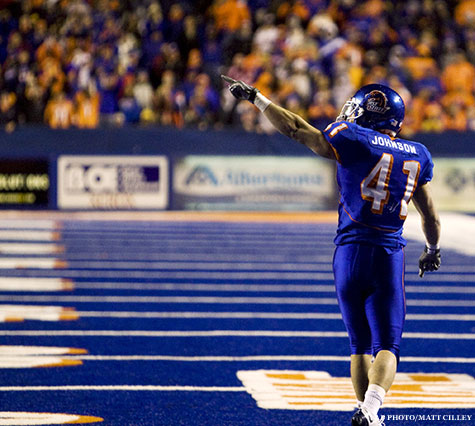What gives a team an extra edge in a big game? Is it the athleticism? The coaching? The
chemistry? Or could it be color?
We all know how Boise State University painted its football field blue as a way to draw
attention to the school. It worked. And the team has won on that field – a lot. Since the
dawn of the blue turf, the team has not lost a home WAC game, it is 77-2 at home since
1999, and Boise is now a national power despite its small size and budget. Coincidence?
Maybe not.
The use of color – and how it resonates in the brain – is still a fairly new science, and
we don’t yet fully understand its power. But color has long been a part of sports culture.
We associate our favorite sports teams by hue: the Red Wings, White Sox, Cleveland
Browns, the Delaware Blue Hens and Syracuse Orange (my personal favorite for obvious
reasons) are among a few teams to incorporate color into their name. And the meaning
behind color affects nearly every area of life: clothing, graphic design, packaging, food
choices, etc. But color can also be a powerful psychological tool. It can be used to send
a positive or negative message, encourage sales, calm or incite a crowd, or even make an
athlete pump more iron.
In academic circles, this is known as semiotics – or, in other words, the study of signs and
symbols. That includes color. Uniforms, equipment, team logos, and even stadiums all
employ the “psychology of color” as a way to convey messages -- whether they know it
or not. This is similar to the way that the color of your car reveals a lot about you: your
personality, your traits, and even how satisfied you are with your life.
So when we look at the connection between sports and color, what does all of this mean?
Research has shown that women from the U.S., Germany and China find men more
attractive and desirable when they are pictured in red. (I argue the same can be said of

men, as women have long-known the power a red dress and some red lipstick.) Another
piece of research found that referees are biased in favor of athletes who wear red. It has
also been found that wearing red is linked to a higher probability of winning across a
range of sports. Some years ago, a study of 56 seasons of English soccer found that,
on average, teams in red won more home games than teams in other colors. Another
report showed boxers dressed in red often performed better. Perhaps this is because our
perception of red has an evolutionary basis, with our forebears knowing it as the color
of blood, power and danger. Athletes may have a subconscious reaction when they see
opponents wearing red, putting them at an inherent disadvantage.
Does this mean sports teams should wear more red? Maybe so. When opponents are
equally matched, the effect of color can be enough to tip the balance in the favor of the
team wearing red. As semiotics advances, maybe we will see NBA and MLB teams
take after the NHL and NFL, in which the darker color is usually worn at home. But a
disclaimer: when there is a clear talent advantage, color has no effect on outcome. Sorry,
but there will be no color doping scandal.
As for blue? Some studies are now showing weight-lifters can lift more in a blue gym.
In fact, almost all types of sports performance are enhanced in blue surroundings. People
tend to be more productive in a blue setting because they are calm and focused on the
task at hand. (This is probably good news for travelers on JetBlue.)
Does that mean Boise State is more calm and focused than opponents? Could be. Blue
also fosters creativity, and we’ve seen what head coach Chris Petersen can do with play-
calling under pressure. Of course the sample size is too small to make conclusions, so
athletic directors might want to wait for more information before heading out to the Behr
or Glidden outlet. And there’s really no viable response for teams like the Tulane Green
Wave. But perhaps eventually Michigan should sub out its Maize Rage fan section for a
Blue Crew. And maybe the Detroit Lions should paint Ford Field blue; they have nothing
more to lose.
Either way, expect more and more teams to get an edge by wearing red and painting the
town blue. Though be careful. Eastern Washington recently colored its football field red.
With too much wear and tear, the Eagles may be playing on pink.
Erica Orange is Vice President of Weiner, Edrich, Brown, Inc., a leading futurist consulting group based in New York City




